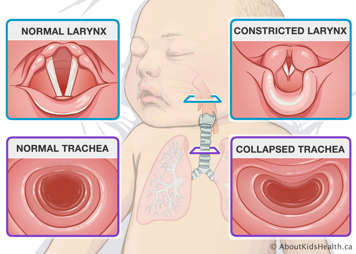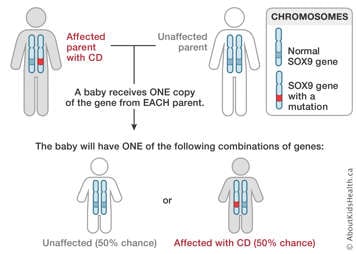What is campomelic dysplasia (CD)?
Campomelic dysplasia (say: cam-po-MELL-ick diss-PLAY-zee-ah) is a genetic condition that affects:
- the development of the skeleton
- the development of the reproductive system
It is characterized by:
- distinctive facial appearance
- Pierre Robin sequence with cleft palate (see below)
- bowing and shortening of long bones
- club feet
Many babies are born with genitalia that are not clearly male or female (ambiguous genitalia).
CD is often life-threatening in the first few weeks of life due to a problem with the airway called laryngotracheomalacia.
Other names you may hear for the condition are camptomelic dysplasia, campomelic dwarfism, campomelic syndrome or camptomelic dwarfism.
It is not known how many babies are born with CD. It is thought that perhaps one in every 40,000 to 80,000 babies is born with CD.
How campomelic dysplasia affects the body
Facial appearance
People with CD have a relatively large head with a flat face. They have prominent eyes, a flat nasal bridge (the area at the top of the nose between both eyes) and a small chin.
Pierre Robin sequence
This is the name given to the following birth defects if they appear together:
- small lower jaw
- tongue that is pushed up and back towards the roof of the mouth (palate) and throat; this prevents the proper closure of the palate
- cleft palate
Many infants with CD are born with Pierre Robin sequence. This can lead to difficulties with feeding and you may need to speak to a feeding consultant.
Height and body shape
Children with CD have shorter arms and legs than normal. Some babies have bowed bones during the prenatal period and may be short from birth, whereas others are born with a normal length. In general, people with CD may also have bowing of the long bones of the arms and legs. This is usually seen more in the legs than the arms. The hip joints are unstable and easy to dislocate. Club feet are quite common in babies with CD.
During childhood, the long bones of the arms and legs grow at a slower pace than usual. This leads to short stature (height) as well as relatively shorter limbs.
The ribs are also affected. People with CD usually have 11 pairs of ribs, instead of the usual 12 pairs. Scoliosis (curvature of the back) is also seen in people with CD.
Abnormal development of sex organs
People with CD often have ambiguous genitalia (not clearly male or female). Often a person who has male chromosomes (46,XY) will have complete female genitalia to ambiguous genitalia. On the inside, they can have both male internal genitalia (testes) and female internal genitalia (ovaries). Both boys and girls can have CD.
Laryngotracheomalacia
Laryngotracheomalacia (say: la-RING-go-TRAY-kee-oh-ma-LAY-sha) is a condition where the larynx (voice box) and trachea (wind pipe) are softer than expected. This leads to airway obstruction and difficulty breathing. Many babies die as a result of this complication.

Deformities of the spine
Instability of the back bone at the level of the neck (cervical spine) is quite common. Progressive scoliosis (curvature of the spine) is also a feature.
Hearing loss
People with CD have a higher chance of hearing loss.
Intellectual development
Children with CD have normal intelligence.
Campomelic dysplasia is a genetic disorder
Genetic means related to genes. Each of us inherits our genes from our parents. They provide our body with instructions that influence our health, looks and behaviour. In general, each person has two copies of every gene. One copy is inherited from the mother and the other from the father.
CD occurs due to a mutation (change) in one copy of the gene known as SOX9. Most cases are new in a family and not passed on by a parent. This is the result of a new mutation that happens by chance in the egg or the sperm cell that created the child.
CD is inherited as an autosomal dominant condition. This means that:
- Only one copy of the SOX9 gene needs to have a mutation for a person to have CD. The other copy of the gene works normally but is not enough to prevent a person from having CD.
- A person with CD has a 50% chance during each pregnancy of passing this genetic condition on to the child.
- The risk to the sibling (brother or sister) of a person with CD depends on whether the parent has CD or not.

Campomelic dysplasia can be diagnosed before or after birth
Before birth, CD can be diagnosed by testing DNA taken from the fetus. This can be obtained in one of the following ways:
- by amniocentesis after the 15th week of pregnancy
- by chorionic villus sampling (CVS) between the 11th and 14th week of pregnancy
These methods are used for high-risk pregnancies, for instance if the parents have another child diagnosed with CD or one of the parents has CD.
To be eligible for this testing, the mutation in the SOX9 gene responsible for causing CD in the family must be known. This means genetic testing (a blood test) must be done on the person in the family with CD.
CD can sometimes be diagnosed by ultrasound in pregnancy. However, a normal ultrasound does not guarantee that a baby will not have CD.
After birth, the diagnosis of CD is based on X-ray findings and physical examination. A diagnosis of CD can sometimes be confirmed by DNA testing of the SOX9 gene (a blood test).
Treatment of campomelic dysplasia
Children with CD can lead fulfilling lives if they receive attentive, informed care from their parents and health-care providers. They should be carefully followed because of the risk of complications.
The goals of treatment are:
- to help children with CD adapt socially and physically
- to treat any complications
Various specialists work together as a team to help children with CD.
Treatment of cleft palate
A team of specialists called the craniofacial team takes care of children with cleft palate (opening in the roof of mouth). Cleft palate is usually treated with an operation to close the opening.
Treatment of bone and joint problems
Club feet and hip dislocations are managed by orthopaedic surgeons. These often require use of splints, casts and sometimes surgery.
Treatment of spine deformities
Spine deformities like instability of the cervical (upper) spine and progressive scoliosis must be monitored. In some cases, an operation may be considered.
Management of patients with ambiguous genitalia
When the internal genitalia do not match the chromosomes' makeup, the gonads (testes or ovaries) are sometimes removed. This is because there is an increased risk of development of cancer (called gonadoblastoma) later in life.
Treatment of hearing loss
Children with CD require periodic hearing assessments to monitor any worsening of hearing. Some children may benefit from wearing hearing aids.
Coping with campomelic dysplasia
The birth of a child with CD is often unexpected and overwhelming. Speak to your health care team if you need help or advice or if you are having trouble coping.
In general, children with visible differences like short stature can have difficulties in school and society. Missing school for many medical appointments can also make children appear different. Encourage your child to participate in activities with other children the same age. As well, try to physically adapt your child's surroundings to support your child and encourage independence.
Genetic counselling for campomelic dysplasia
People with CD and their families should consider assessment by a geneticist and genetic counsellor. They can help with the following:
- confirming the diagnosis
- discussing the natural history of the disease
- evaluating the risk that future children will also be affected
- discussing available options for managing the disease
Resources and support
The following organizations and sites can offer more information, support and contact with other affected individuals and their families.
- The Human Growth Foundation: www.hgfound.org
- Little People of Canada: https://littlepeopleofcanada.com/
- Little People of Ontario: www.littlepeopleofontario.com/
- Little People of America: www.lpaonline.org
- The Magic Foundation: www.magicfoundation.org
- MUMS (Mothers United for Moral Support) National Parent-to-Parent Network: www.mums-network.org